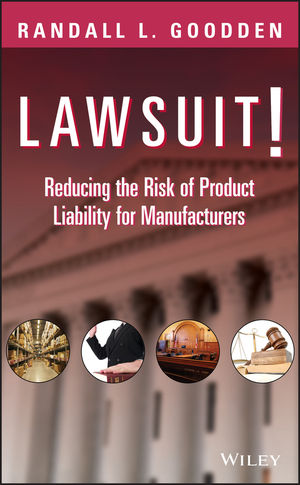Lawsuit!: Reducing the Risk of Product Liability for ManufacturersISBN: 978-0-470-17797-6
Hardcover
392 pages
January 2009
 This is a Print-on-Demand title. It will be printed specifically to fill your order. Please allow an additional 10-15 days delivery time. The book is not returnable.
|
||||||
Preface xiii
Acknowledgments xv
1. An Introduction to Products Liability 1
1.1 Courts and Jury Perceptions 4
1.2 Judicial Hellholes 5
1.3 Legal Reform 7
1.4 Impact on Manufacturers 8
1.5 Public Perception of Corporations 10
1.6 Product Liability from the Insurance Perspective 15
1.7 Insurance Companies Supporting PLP Programs 18
1.8 Recommendations that Can Be Used on Products Liability Accounts Related to Design, Advertising, Instructions, and Product Recall 20
1.9 Tougher Requirements from the CPSC 22
1.10 #1 Verdict of 1999: $4.9 Billion Against GM for Gas-Tank Explosion—Live Defense Demonstration Backfires and Turns the Tide 26
2. Product Liability Around the World 35
2.1 United States 38
2.2 Australia 50
2.3 Canada 59
2.4 China 67
2.5 Europe: Part 1 71
2.6 Europe: Part 2 76
2.7 Japan 83
3. Product Liability Law 93
3.1 Restatement Third of Torts 94
3.2 Commonly Used Terms and Definitions 98
4. New Product Introduction: More Effective Design Reviews 115
4.1 The Different Stages or Types of Design Reviews 122
4.2 Creating the Design Review Team 123
4.3 Making Design Reviews the Policy 125
4.4 Developing the Design Review Procedure 127
4.5 Minutes of the Design Review 131
4.6 Policies and Procedures—Assets and Liabilities 131
4.7 Engineering Change Control 132
4.8 Traceability and Recall Preparedness 133
4.9 Measuring the Effectiveness of the Design Review Team 134
4.10 In Conclusion 134
5. New Product Introduction: Product Safety Reviews Hazards Analysis, and Risk Assessment 135
5.1 Creating the Product Safety Team 136
5.2 Elements of the Hazards Analysis 137
5.3 Design Review—a Viewpoint of the Consumer Product Safety Commission (CPSC) 138
5.4 Failure Mode and Effects Analysis (FMEA) 139
5.5 Cause-and-Effect Diagram 142
5.6 MIL-STD 882 143
5.7 Hazards Analysis Software 148
6. Product Testing 149
6.1 The Initial Design Process 150
6.2 Conducting Product Tests 150
6.3 Building a Testing Lab 151
6.4 Complying with Domestic or International Standards 154
6.5 Testing Products and Reacting to Test Results 154
7. Warnings and Instructions 157
7.1 The Legal Duty to Warn 158
7.2 Presumption 159
7.3 No Need to Warn Sophisticated Users 160
7.4 The 2007 ANSI Z535.4 Standard for Product Safety Signs and Labels 161
7.5 The New Standard: ANSI Z535.6 173
8. Product Warranties 179
8.1 Examples of Warranty, Warranty Disclaimer, and Exclusive Remedy 180
8.2 Limitation of Liability 180
8.3 A Businessperson’s Guide to Federal Warranty Law (http://www.ftc.gov) 181
8.4 Offering Service Contracts 199
8.5 Statement of Terms and Conditions 200
8.6 Disclaimer or Limitation of Implied Warranties 200
9. Product Marketing 201
9.1 Deceptive Advertising v. Defects in Marketing 204
10. Contracts, Purchase Orders, and Agreements 207
10.1 Lack of Supplier Control 208
10.2 Guilty by Association 209
10.3 Purchase Orders 210
10.4 Recall Considerations 212
10.5 Distribution of the Purchase Order Terms and Conditions 212
10.6 Customer Contracts 213
10.7 The China Syndrome 215
10.8 Restructuring Import Contracts When Importing Goods from China 216
11. Records Retention and Dangerous Documents 227
11.1 Records Retention Programs 228
11.2 Hard Copy Storage 229
11.3 Records can be Key for Defense 231
11.4 Document Management and Recognizing “Dangerous Documents” 233
11.5 Electronic Documents and Discovery 239
11.6 The New e-Discovery Burden 240
11.7 Employee Education 242
12. The Administrative Team 243
12.1 Selecting a Primary Driver 244
12.2 Creating the Administrative Team 245
12.3 Gaining the Necessary Knowledge 246
12.4 Announcements to the Rest of the Organization 246
12.5 Selecting an Outside Attorney 247
12.6 Auditing the Operation 247
12.7 Developing an Implementation Plan 252
12.8 Administrative Team Meetings 253
12.9 Executive Action—a View from the CPSC 254
13. Post Sale Duties to Warn and Recalls 257
13.1 Estimating the Economic Impact of Product Recalls 260
13.2 “Made in China” Recalls of 2007 260
13.3 Implementing a Recall 262
13.4 Developing a Procedure 263
13.5 The Tylenol Recall 266
13.6 Government Agencies Involved with Certain Product Recalls 267
13.7 EU Recall Planning Guide 288
13.8 Some Final Thoughts on Recall Prevention 297
14. The Quality System: Incorporating Safeguards into the Procedures 299
14.1 The Legal Focus on Quality 301
14.2 How Quality Can Become a Liability 301
14.3 The PLP Problem with Quality Programs 302
14.4 Evaluating the Quality Program 304
14.5 Incorporating PSLP into the Quality Program 305
14.6 Product Safety and Quality Guidelines by the CPSC 307
14.7 Product Safety Policy 307
14.8 Organization 307
14.9 Training 307
14.10 Technical Guidance 308
15. Claims and Investigating Incidents 315
15.1 How The Company Learns About Problems 316
15.2 In-House Awareness Training 317
15.3 Preparing for an Investigation 319
15.4 Gathering the Facts 321
15.5 Inspecting the Evidence 322
15.6 Writing a Report 324
16. Entering into Litigation 327
16.1 Selecting the Defense Attorney 328
16.2 Product Liability (Civil Case) Trial Procedure 329
16.3 Appellate Procedure 330
16.4 Discovery: Interrogatories 331
16.5 Discovery: Requests for Documents 332
16.6 Discovery: Depositions 333
16.7 Preparing for Trial: Testifying Expert v. Non-Testifying Expert 334
16.8 Pretrial Stage: Mandatory Settlement Conference 335
16.9 Pretrial Defense Strategies: Motion in Limine 335
16.10 Discovery: Defense Strategies 335
16.11 Assessing Damages and Punitive Awards 343
16.12 Product Liability Case Studies from Appellate Courts 344
Index 353



